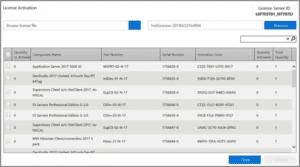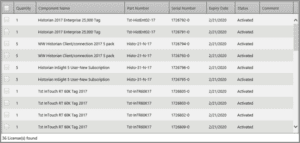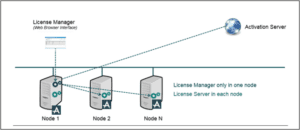AVEVA Enterprise Licensing Overview
This Training Document is avaiable for public viewing. Access to our full library of training documents is included with any current Industrial Software Solutions Training Subscription.
To learn more about ISS Training Subscriptions and pricing, please contact us.
CONTACT US
OVERVIEW
The AVEVA Enterprise Licensing platform is a common platform that allows you to effectively and efficiently manage AVEVA software product licenses. This licensing system was introduced to allow centralized license management and increase license security by use of Activated licenses. It is composed of a browser-based License Manager and a License Server that together allow you to share and deliver licenses for your installed products. This training document will provide an overview to this system and explain different licensing concepts:
Key licensing concepts and terms are defined below:
| Term | Description |
|---|---|
| Entitlement File | An XML file that contains the Activation IDs that enable product functionality. |
| Activation ID | A code that identifies a specific product license and enables activation. |
| License Activation | The process of enabling a particular License Server to consume and serve out particular product functionality. Activation can be done online (typical) or offline (off-site). |
| License Reservation | Allows one to reserve particular license components so they can only be acquired by a particular computer or user. |
| Borrowed Time | If a computer loses communication with the License Server when it comes to time for the product to renew the license, then it will expire after a certain time. This time period is called Borrowed Time. |
| Grace Period | A condition the License Server can go into based on different actions, such as cloning a virtual machine with licenses activated. Grace Period allows you to perform normal licensing functions for 15 days. Once the Grace Period expires, the License Server can no longer server licenses and the grace period condition must be removed. For more information on Grace Period, see ISS Tech Note 117. |
| Redundancy | The licensing system can be configured for high availability and disaster recovery by configuring redundant license servers. For information on configuring licensing redundancy, please see AVEVA’s Tech Note on License Server Redundancy. |
APPLIES TO
-
AVEVA Enterprise Licensing
EXPLANATION
Section 1 – Licensing Workflow
The following section describes the basic workflow for utilizing the activation-based license system. This example assumes that both License Manager and License Server are installed on the same computer, and that the computer can connect to the Internet.
- Obtain license files for AVEVA software. These will be in the form of XML licenses, referred to as Entitlement files.
- Start License Manager. It opens in a browser window and allows you to view, add, and manage License Servers.
- Select a License Server. The License Server is where you can activate the licenses.
- Import the Entitlement file: Once imported, License Server displays the available licenses. Multiple product licenses can be included in a single entitlement file and will show up as different product lines during activation.
- Activate licenses: License Manager connects to the AVEVA Activation Server over the Internet to activate the selected licenses on the License Server. You can also activate licenses offline, which really means off-site, as it still requires internet access on an external computer. For more information on activating licenses, see Section 4.
- Licenses are now available for their respective product to use. In license server, you can now activate new licenses, deactivate current licenses, and reserve/unreserve licenses.
- Run Configurator on the computer(s) where AVEVA software products are installed to point them to a particular license server and allow them to pick up their respective product licenses.
Section 2 – Licensing Components
AVEVA Enterprise licensing includes the following components:
License Manager
- Allows you to quickly access and maintain licenses for certain AVEVA Enterprise Software products. License Manager offers the following features:
- Browser-based for scalability and ease of use; can be remotely accessed by any supported web browser.
- Light-weight, standalone software you can install on the same node as the License Server computer, or on any other node based on your deployment needs.
- Manage one or multiple License Servers to best organize and manage the licenses in your unique environment.
License Server
- Provides the functionality to activate/deactivate, view, maintain, and serve licenses to your installed AVEVA software products. License Server offers the following features:
- Easily host and maintain your software licenses
- Securely serve any types of software application being licensed, including Windows browsers, tablets, and mobile devices.
- Provide current license usage information.
Activation Server
- A cloud-based Internet accessible server to which the License Manager connects for license activation. The License Manager connects to the AVEVA Activation Server in the Cloud only temporarily during the
activation process. It is not something directly accessed by the user during online license activation.
Section 3 – License Topologies
AVEVA Enterprise Licensing allows you to serve licenses to products on a computer locally in a Single Node topology, or serve license from a central computer on the network in a Distributed Topology.
Single Node
In this configuration, a single computer has both the installed AVEVA Software product and the License Manager and License Server installed. Communication between the software and licensing components is all local.
Distributed Topology
In this setup, the licensing components can be installed on a central computer with all the software installed on other computers, as long as there is reliable network connectivity between all the computers. Redundancy is recommended in this configuration as well. Some different examples of this topology are shown below.
A single License Manager connecting to multiple license servers
One License Manager per License Server
Centralized License Topology
Section 4 – Activation and Reservation
License Activation enables the use of a purchased license on a server. The activation server validates an Activation ID and provides an activated XML license file in return. This file contains multiple Activation IDs, one for each purchased license. The XML file can be activated by connecting the local License Server to the Cloud-based Activation Server using the License Manager application. License acquisition takes place when a product is launched. The product obtains its activated license from the License Server while running and releases it upon shutdown. The license cannot be used by another product until it is released back to the License Server.
Online activation will be described in this section.
For information on offline activation, please see ISS Tech Note 118.
Activating a License Online
- Open the License Manager -> License Server and click Add License.

2. The License Activation panel appears. In the Browse License File area, click the button to browse to your Entitlement File to import it.

3. Check the components you wish to activate and then click the Activate button. The License Server will send the request to the Activation Server.
4. The License Activation panel closes and the selected licenses show “Activated” status in License Summary.

License Reservation
The AVEVA Enterprise Licensing model supports concurrent and reserved licenses. Concurrent licenses are the default and operate on a first-come-first-served basis.
In the reserved license model, specific devices or users are assigned licenses. Only one reservation can be made per license, but if a license has multiple parts (e.g., multiple clients), each part can be reserved individually. When all concurrent licenses are taken, new users or devices are denied unless a reservation is in place or concurrent licenses become available. Reservations are necessary when there are licenses with unique functionality that need to be assigned to specific devices.
There are two types of license reservation:
- Device Reservation: Assigning a specific product license to a device ensures that authorized users accessing that device can use the reserved license. This applies to servers, back-end applications, and clients, depending on the product configuration and functionality. Refer to the product documentation for more details.
- User Reservation: Reserving a license for a specific user guarantees that the user can use the reserved license, especially when they require access from different devices at different times. Some products automatically reserve licenses for users when acquired, eliminating the need for manual reservation.
These methods can be applied in the Device Reservation and User Reservation tabs in License Server respectively.
All Industrial Software Solutions Training Documents are provided "as is" without warranty of any kind.



